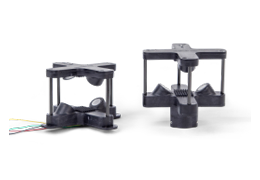Calibration and maintenance
The LI-550 requires very little maintenance. The sensor can be user-calibrated, as described below. The firmware can be updated as well.
User calibration
Every LI-550 is tested and calibrated prior to shipping. You can re-calibrate the sensor to acclimate to unique use cases or local conditions by following these directions.
Transducer distance calibration
Place the LI-550 inside a small container to reduce the airflow to as close to zero as possible. Take care to eliminate acoustic reflections from hard sides and to not block the acoustic pathways. There should be some sound absorbing material on any flat walls that could reflect sound back towards the LI-550. A small box with acoustic absorption foam is ideal. However, in a pinch you can successfully calibrate a LI-550 by loosely wrapping a coat or towel around it. The main thing is to provide a zero-wind environment, and to know the temperature, and ideally the humidity, of the air volume where the LI-550 is enclosed.
Type calibrate <temp> [<rh>] where the <temp> = xx.x °C temperature and <rh> = xx.x% relative humidity (optional). If humidity is not supplied, then 50% is assumed. This command then uses the supplied temperature and RH to compute the speed of sound which is then used to compute the distances between transducers. It does not calibrate the temperature or RH readings.
The calibration cycle takes ten seconds. You will see dots in the serial console indicating progress, and the prompt will return when the calibration is completed. Enter nvwrite to store the new calibration values in non-volatile memory.
Level calibration
The calibration function of the level is simply an offset adjustment for the accelerometer inside the LI-550. Place the LI-550 on a level surface such that the bottom surface of the LI-550 is parallel with the level surface (accommodate the wires by providing a channel or hole). While the LI-550 is level, execute the levelcalibrate command. Enter nvwrite to store the values in non-volatile memory.
Compass calibration
The compass calibration acclimates the compass module in the LI-550 to the local magnetic field. Start the compass calibration by using the compasscalibrate command. The compass calibration is active for fifteen seconds after initiation. During this time, tilt and rotate the LI-550 into as many orientations as possible using a three-dimensional figure-eight pattern. Enter nvwrite to store the values in non-volatile memory.
Recovering from a bad calibration
If, after calibrating temperature and relative humidity, the readings are not correct, reset the instrument to factory defaults in Expert mode, then try to calibrate again. Be sure to exit expert mode before storing the new calibration to non-volitile memory using nvwrite.
Cleaning the sensor
Disconnect the LI-550 cable or wires from power, but be sure to keep the cable or wires attached to the LI-550 to keep water off of the terminals.
Rinse the outer surface of the sensor gently with water. Be careful to avoid spraying water at the vent on the base of the sensor.
If the exterior surface needs more cleaning, wipe the exterior surfaces with a soft lint-free cloth. The cloth may be either dry or wet with ordinary soap and water.
Firmware updates
Firmware updates will include bug fixes and feature improvements. Any LI-550 TriSonica Mini can be updated to the latest firmware except devices running firmware 1.2 and older.
Updating firmware
You can download the latest firmware release at licor.com/support/LI-550/software.html. Save the program to your computer. Connect the LI-550 to that computer. From this point, choose a method of to load the update:
Using the TriSonica application:
- In the Settings Tab click Browse….

- Navigate to the downloaded file and select it.
- Click Update Software.
- The LI-550 will copy the new files and the new version number will be displayed.
- Perform a user calibration (see User calibration).
Using Tera Term (Terminal Emulator):
- With the LI-550 connected to the terminal program, press CTRL+C.
- Type
programupdate YES. - From the Tera Term menu, select the following: File > Transfer > YModem > Send.
- Select the file to upload and press Enter.
- Perform a user calibration (see User calibration).
Updating the bootloader
Two programs reside in the internal memory of the LI-550: the LI-550 application and a bootloader. During a reset or power on, the bootloader checks to determine if the LI-550 application is valid. If the sensor application is valid, the bootloader turns over control to the sensor application. If the sensor application is not valid, the bootloader shows a command line interface with a limited set of commands: help, programupdate, systemreset, and factoryreset. These commands perform the same functions described in Configuring with the command-line interface.
Follow these steps if you need to update the Bootloader:
- Update the LI-550 application.
- Enter the command line interface.
- Enter the expert mode with the command
expert enable. - Enter the command
bootloadupdate YESto update the bootloader.
